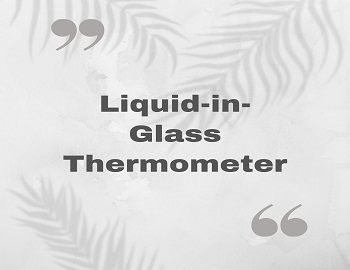Liquid-in-Glass Thermometer:
Mercury thermometer is widely used for day-to-day work. They are calibrated by the use of ice and steam points and therefore read on the Celsius scale. The thermometer is quick and gives temperature directly. The range of mercury thermometer is not very wide since mercury boils at 356°C and freezes at -39°C. For measuring high temperature either mercury is used under pressure or some other high boiling point liquid like gallium (B.P. 1700°C) is used. For low-temperature measurements, alcohol can be used up to -112°C, petroleum either up to –190°C and pentane even up to -200°C.
The mercury and other liquid-in-glass thermometers suffer from several inaccuracies and therefore need corrections. Some important sources of error and corrections needed are as follows-
(I) Shift of Zero- If the bulb of a finished thermometer is placed in melting ice contained in a funnel so that water formed is drained away, it is in general found that the mercury thread does not stand at zero. The shift of zero of the thermometer is due to the fact that the glass tube of the thermometer heated during the process of manufacture does not return to the original volume on cooling. The recovery is gradual and takes a few years.
(II) Error in Upper Fixed Point- The finished thermometer should be placed in the hypsometer and its upper fixed point should be checked. The difference between the true boiling point corresponding to the pressure of the day and the observed reading gives an error of the fixed point.
After obtaining zero error and error in the upper fixed point a straight line graph can be drawn which will give the correction for any reading of the thermometer.
(III) Exposed Stem Correction- When a thermometer is placed in a hot bath, a part of a stem always remains outside and is therefore at a different temperature from the bulb. The reading shown by the thermometer will, therefore, be slightly lower than the true temperature. The maximum possible length of the thermometer should be immersed in the bath to minimize this error.
(IV) Lag Error- A thermometer that has been used for measuring high temperature should not be used immediately for measuring low temperature. When the bulb of the thermometer is heated and then cooled, the glass bulb does not recover its original volume immediately and therefore the thermometer will not give the correct reading if it is used immediately for measuring lower temperatures.
(V) Internal Pressure Correction- A thermometer is graduated in a horizontal position. A correction is therefore necessary when the thermometer is used in a vertical position to allow for the increased internal pressure on the walls of the thermometer bulb.
(VI) External Pressure Correction- If the outside pressure is increased, it would compress the bulb and the mercury will rise higher in the stem. The error due to external pressure variation is very small.
(VII) Non-uniformity of Bore- The stem of the thermometer is graduated by dividing the length uniformly assuming the bore of the thermometer to be uniform. To avoid the error of non-uniformity of the bore, the thermometer must be calibrated with the help of some standard thermometer.
(VIII) Capillary Error- Since the bore of the thermometer is very fine, mercury cannot move freely and therefore, a rising column always reads somewhat lower than a falling column at the same temperature.









Comments (No)